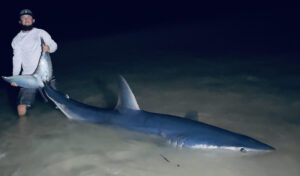
Florida International University (FIU) graduate student and Ph.D. candidate Devanshi Kasana was tagging tiger sharks in the Caribbean Sea with a group of local fishermen. They were in the Central American country of Belize when they ran across something none would have dreamed to discover.
A report from the prestigious Mote Marine Laboratory & Aquarium in Sarasota, Florida details what happened:
Kasana and the fishermen were checking some baited fishing lines when one unusual catch suddenly appeared.
On one line wasn’t a tiger shark, but a rather sluggish creature. Kasana said it looked old — even ancient — and more like an elongated, smooth stone that had sprung to life. It had a blunt snout and small pale blue eyes.
“At first, I was sure it was something else, like a six-gill shark—that are well known from deep waters off coral reefs,” Kasana said. “I knew it was something unusual and so did the fishers, who hadn’t ever seen anything quite like it in all their combined years of fishing.”
Kasana texted Demian Chapman — her Ph.D. advisor and Director of Sharks & Rays Conservation Research at Mote — to share the news. She also sent a photo of the shark. Chapman said it wasn’t a six-gill shark, but looked a lot like a Greenland shark.
Several shark experts were contacted, and it was confirmed Kasana’s shark is a “sleeper shark,” likely a Greenland sleeper shark or perhaps a hybrid from the Greenland and Pacific “sleeper shark” families.
The Mote Laboratory reports the Greenland shark is most common to the frigid waters of the Arctic and North Atlantic oceans and are extremely slow growing, and can be hundreds of years old. Their vision is so poor they are about half blind.
The species can live 250 years, and perhaps more than half a century. They are the longest-living vertebrate species known. They’re believed to live in freezing Arctic waters, scavenging on polar bear and whale carcasses.
Because little is known about Greenland sharks, nothing can be definitively ruled out about the species, contends Mote Marine. Greenland sharks could possibly be swimming the frigid depths of the oceans all around the world.
Authorities say Kasana’s discovery is the first Greenland “sleeper shark” found in the tropical Caribbean Ocean, which is over 9,000 feet deep and near where Kasana was fishing. And that’s where maybe more “sleeper sharks” are sliding across the depths of even warm oceans.
One of the world’s top experts on Greenland sharks — University of Windsor Associate Professor of Biology Nigel Hussey — gave the Kasana shark team four satellite tags to fit in more sleeper sharks if they’re discovered.








